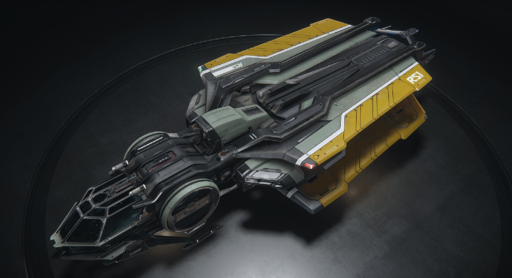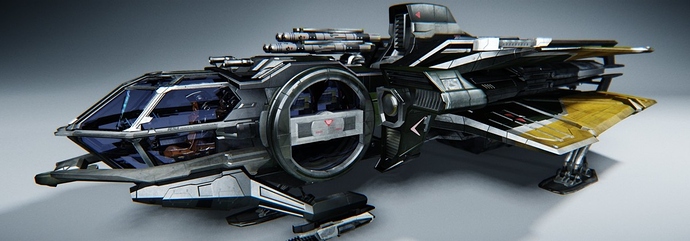That sounds like Elite Dangerous, except worse!
K. I’ve never played that. So you may be correct!
OK so even though these frames of reference are essentially just matrix transforms of one another, what you’re saying is that because it’s such a rarity, the common available libraries don’t support it, and it has to be patched in. I hear that, but this may also explain why the physics is so incredibly buggy in this game, ie. they’re not doing an amazing job with this.
That’s my impression as well. 3.4 seems to handle more realistically, with gravity causing the ship to descend when pulling high angle turns. It seems like the new system in 3.5 was about value tweaking, at least from this video.
I am impressed that they even have atmospheric flight – I didn’t realize it entered a different mode. There’s also no evidence of real drag or lift – they just plug some numbers per model such as maximum speed. For example, that block spaceship should probably not be able to fly at all in any atmosphere like ours. To be fair though, I don’t think even real flight sims (except for X-Plane) model real drag and lift – my comment about that was more to prompt for additional info out of Juan.
If it’s at a very fundamental level, saying they simply “patched” a few things in may not be a fair statement, IMO.
Well, back when engines used to do their own physics, you’d just program this stuff in at a low level. Now everyone uses physx, so it’s likely about patching several instances of physx to work together, since no company is going to rebuild physx from scratch. That’s what I meant by ‘patching’. Given the number of specifically physics problems in the game, whatever they did, they apparently messed it up quite badly.
Is Physx used only for CryEngine, or do multiple engines use it?
It’s used by just about every big engine nowadays. It was created by Nvidia (actually it was a startup that was acquired by Nvidia) and can only be accelerated on Nvidia cards. The wikipedia article goes into more detail.
It’s worth noting that physics isn’t really required or used for most things in games that aren’t specifically physics-based. Ragdolls require it, as does computation of realistic debris that falls and hits stuff. Dropping objects could use realistic physics, but it’s not a requirement – you could use much more basic behavior. Usually you just have basic approximations of physics and it’s good enough. So it’s not really clear how much they really have to do to PhysX in the case of SC, or how they do it.
BTW my guess is that they’re only using one instance of PhysX in a global frame of reference. In other words, they don’t really have multiple frames of reference in the game. This could be why delivery crates constantly fall through the floors of ships – they don’t have a simplified method to place the crate on the floor, but instead rely on physx’s force vector going down in the ship (which could be at any orientation) to check that the crate rests on the floor, and high end physics computation is highly imperfect – sometimes the floor constraints are missed and the object just clips through the ship.
Yeah, I understand. That’s not really going to fly except in one’s imagination. Which is fine, I’m not holding that against the game. You can’t expect them to have the ships designed by aeronautical engineers.
Unless you know, it has a bunch of vectored theaters positioned all over it.
I mean, sure, it’s a space ship in a video game, so it’s not real.
Hmm. That makes sence (at least to me).
So, any idea why SC may seam to NOT have the “crates falling through the floor” issue from time to time? I mean, as far as I’ve observed, that issue seams to not only come and go with each “release” but also comes and goes from time to time (game play session to session).
It also seams to me (subjectively) to become more prominent the longer any new release is out. As if a new release appears much more stable regarding the “crate falling” issue at first, but then becomes less consistent
over time. Maybe just my perception?
I guess the real answer is that it looks cool!
I guess the real answer is that it looks cool!
No, I just looked at it. That’s not the answer either.
It also seams to me (subjectively) to become more prominent the longer any new release is out. As if a new release appears much more stable regarding the “crate falling” issue at first, but then becomes less consistent
over time. Maybe just my perception?
I don’t know, but here’s my guess: the PhysX thread has to run on the server and check everything in the instance, because everything really happens on the server. The more people on the servers, the less CPU cycles are available per instance, and the lower FPS the game gets per instance. PhysX works by calculating the constraints per frame (really ‘tick’ on the server, since the server doesn’t render anything). If the tick rate goes too low due to lack of resources, the distance the crate travels between ticks may exceed the floor of the ship. At that point, the collision is missed, and the crate continues to travel on its merry way past the floor.
BTW my guess is that they’re only using one instance of PhysX in a global frame of reference. In other words, they don’t really have multiple frames of reference in the game.
Not really my area, and I don’t know how the game implements it, but I’d think, at the vastly different scales the simulation runs, you’d quickly get rounding errors with the simple traditional approach of a sequence of matrix calculations. Do you, or anyone else, have any information to share on how the rare game where it’s relevant deals with that issue?
Yeah, I understand. That’s not really going to fly except in one’s imagination. Which is fine, I’m not holding that against the game. You can’t expect them to have the ships designed by aeronautical engineers.
Do spaceships need aeronautics in the vacuum of space? And isn’t any spacecraft that flies in the atmosphere going to so advanced that aeronautics won’t really matter? I mean if you have a hyperdrive or equivalent, surely you don’t have to worry about wings holding you up in the air, right?
Do spaceships need aeronautics in the vacuum of space?
Nope.
And isn’t any spacecraft that flies in the atmosphere going to so advanced that aeronautics won’t really matter? I mean if you have a hyperdrive or equivalent, surely you don’t have to worry about wings holding you up in the air, right?
I guess that’s true. Assuming propulsion systems that only push (which most games sort of do), if you have thrusters on the bottom of your ship keeping you up, a back thruster could move you forward. I think that’s what @Timex was getting at. In that case though, you’ve kinda lost the significance of any difference between in-atmosphere flight and space flight, and there’s no need to suddenly have pitch vs yaw-only. Nor is your turn rate limited, which is the thing that makes atmospheric flight interesting.
I guess that’s true. Assuming propulsion systems that only push (which most games sort of do), if you have thrusters on the bottom of your ship keeping you up, a back thruster could move you forward.
Or, if you have wing like structures, like the Aurora, even though they aren’t actually wings that are providing lift through the Bernoulli effect, you can use them combined with air resistance to create a gliding effect.
Then, all you need to do is have the ability to generate thrust, and keep your nose up. The wing structures aren’t creating lift, as much as they are providing a control surface.
And you can see this in end of the video, where the guy talks about being able to actually glide down to the surface in 3.5, even without power, as long as you keep your nose up.

